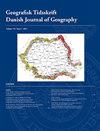Spatial patterns and drivers of fire occurrence in a Mediterranean environment: a case study of southern Croatia
IF 1.1
4区 社会学
Q4 ENVIRONMENTAL STUDIES
Geografisk Tidsskrift-Danish Journal of Geography
Pub Date : 2017-01-02
DOI:10.1080/00167223.2016.1266272
引用次数: 20
Abstract
Abstract Wildfires are an important factor of landscape dynamics in fire-prone environments of the world. In the Mediterranean, one of the most fire-susceptible environments globally, between 45,000 and 50,000 wildfires are recorded every year, causing disturbances in forest and grassland ecosystems. As a Mediterranean country, Croatia faces these problems, averaging over 1000 registered wildfires annually, with the coastal areas dominated by forest fires and continental Croatia by fires on agricultural lands. This research combines various landscape and socio-economic factors in the analysis of fire occurrence in Croatia’s southernmost region of Dalmatia. Around 275 of the largest fires (encompassing 98% of the total burnt area) registered in 2013 were investigated using OLS, and different spatial indices were employed to analyse regional variability in fire distribution. The results revealed that areas more prone to fires are the northern inland areas of Dalmatia and its entire coastal zone. Altitude and vegetation type demonstrated a correlation with fire occurrence, but an increase in population in the study area was also correlated with wildfire occurrence. Regarding vegetation, the grasslands and Mediterranean shrubland (maquis) were found to be the most fire-prone vegetation types in the study region, the distribution of which can be linked to different socio-economic and demographic processes occurring in the Eastern Adriatic.地中海环境中火灾发生的空间模式和驱动因素:克罗地亚南部的案例研究
摘要野火是世界上火灾易发环境中景观动态的重要因素。地中海是全球最易受火灾影响的环境之一,每年发生4.5万至5万起野火,对森林和草地生态系统造成干扰。作为一个地中海国家,克罗地亚面临着这些问题,每年平均有1000多起已登记的野火,沿海地区主要是森林火灾,克罗地亚大陆主要是农业用地火灾。本研究结合了克罗地亚最南端达尔马提亚地区火灾发生的各种景观和社会经济因素分析。使用OLS对2013年登记的275起最大火灾(占总燃烧面积的98%)进行了调查,并采用不同的空间指数来分析火灾分布的区域差异。结果显示,更容易发生火灾的地区是达尔马提亚北部内陆地区及其整个沿海地区。海拔高度和植被类型与火灾发生有相关性,研究区人口的增加与火灾发生也有相关性。在植被方面,草原和地中海灌木地被发现是研究区域最容易发生火灾的植被类型,其分布可能与东亚得里亚海发生的不同社会经济和人口进程有关。
本文章由计算机程序翻译,如有差异,请以英文原文为准。
求助全文
约1分钟内获得全文
求助全文
来源期刊
CiteScore
5.20
自引率
0.00%
发文量
5
期刊介绍:
DJG is an interdisciplinary, international journal that publishes peer reviewed research articles on all aspects of geography. Coverage includes such topics as human geography, physical geography, human-environment interactions, Earth Observation, and Geographical Information Science. DJG also welcomes articles which address geographical perspectives of e.g. environmental studies, development studies, planning, landscape ecology and sustainability science. In addition to full-length papers, DJG publishes research notes. The journal has two annual issues. Authors from all parts of the world working within geography or related fields are invited to publish their research in the journal.

 求助内容:
求助内容: 应助结果提醒方式:
应助结果提醒方式:


